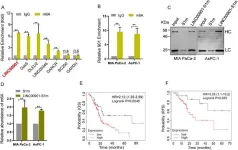The antibiotic cefazolin is an essential drug according to the World Health Organization (WHO). It is usually produced via batch manufacturing, but this multistep process is time-consuming, wasteful and requires very specialized facilities. Now for the first-time, researchers have manufactured cefazolin using the continuous-flow method. This method is cheaper, quicker, less wasteful and more flexible in terms of how much drug can be produced when it’s needed. Improving access to cefazolin is vital for global health and particularly relevant for countries such as Japan, which experienced a shortage in 2019. This study is published in the Bulletin of the Chemical Society of Japan.
If you’ve ever had a sore strep throat or painful urinary tract infection, then you’ve probably been prescribed antibiotics to help you recover. Antibiotics are one of our greatest weapons against serious bacterial infections and our need for them is increasing. Cefazolin is one such drug, which is so important to human health that it has been designated an essential medicine by the WHO. It is used to cure a broad range of ailments such as urinary tract, respiratory and joint infections, and to prevent infection after surgery.
As with most drugs, cefazolin is made via batch manufacturing, a step-by-step process enabling precise control at each stage. However, it is time-consuming and requires plenty of space in a carefully controlled site to minimize risks such as contamination. Due to the time frame, specially equipped and controlled space, and large amount of waste, production costs are not inexpensive and are particularly high when setting up new facilities.
An alternative to batch manufacturing is continuous-flow manufacturing. This method had not widely been used by drugmakers because it is more challenging to control the reactions taking place. However, researchers at the University of Tokyo have now developed a way to safely create cefazolin through continuous-flow manufacturing
“The method we have developed can cover mass production within compact manufacturing facilities, does not incur huge equipment costs, and can provide a pharmaceutical-grade drug safely and securely,” explained Professor Shu Kobayashi from the Department of Chemistry at the Graduate School of Science.
“Demand for this antibiotic fluctuates wildly and it is a drug that is better to not prepare too far in advance due to its instability,” said Project Professor Haruro Ishitani, also from the Department of Chemistry. “So a big benefit of the continuous-flow method is that it is easy to adjust the production volume as needed.”
As the name implies, continuous-flow manufacturing doesn’t require pauses in between multiple individual steps, unlike the batch method. The team used two connected reactors to produce cefazolin from readily available commercial raw materials. The raw materials and reagents, which facilitate the reaction, were pumped into the first reactor, which looks like a coiled thin metal tube, before moving into a second reactor where another raw material was added. From there flowed the cefazolin. It was a challenge for the team to optimize the environment inside the reactors, i.e., the temperature, transfer speed and mixing ratio of reagents, etc., to be able to obtain a high-purity product at the end, particularly due to the complex structure of cefazolin. According to the researchers, this method was substantially superior to conventional batch manufacturing and could even be optimized further.
Kobayashi and Ishitani were motivated to undertake this research by their concern over Japan’s lack of facilities to domestically manufacture important drugs like cefazolin when needed, instead relying heavily on imports. Their fears were realized in 2019 when Japan experienced a serious shortage of cefazolin, due to contamination of an active ingredient from overseas, causing a crisis. Not only would the continuous-flow method be easier and cheaper to implement on a nationwide level than building more batch-method facilities, but it could also help smaller communities and hospitals manufacture essential drugs as and when they want.
“Many compounds can be synthesized by continuous-flow methods,” said Ishitani. “By adopting this method, we believe that we can contribute to a stable drug supply, respond to rare diseases and disasters, and aid new drug development. In addition to that, we believe that it is possible to contribute to producing other chemicals, such as for agricultural use, and the realization of a low-carbon society, which is another pressing social issue.”
#####
Paper Title:
Shoichi Sugita, Haruro Ishitani, Shu Kobayashi. A practical and convenient synthesis of the essential antibiotic drug cefazolin under sequential one-flow conditions. Bulletin of the Chemical Society of Japan. doi: 10.1246/bcsj.20230113
Funding
This research was supported by the Japan Agency for Medical Research and Development (AMED) under Grant Number JP 22ak0101145.
Useful Links
Graduate School of Science: https://www.s.u-tokyo.ac.jp/en/index.html
Department of Chemistry: https://www.chem.s.u-tokyo.ac.jp/en
Synthetic Organic Chemistry Laboratory (Kobayashi group): http://www.chem.s.u-tokyo.ac.jp/users/synorg/en/index.html
Green & Sustainable Chemistry Social Cooperation Laboratory: https://www.chem.s.u-tokyo.ac.jp/users/gsc/index_J.html
Research Contact:
Project Professor Haruro Ishitani
Department of Chemistry
Graduate School Science
The University of Tokyo
7-3-1 Hongo, Bunkyo-ku, Tokyo 113-0033, Japan
Email: hishitani@chem.s.u-tokyo.ac.jp
Tel.: +91-3-5841-8343
Press contact:
Mrs. Nicola Burghall
Public Relations Group, The University of Tokyo,
7-3-1 Hongo, Bunkyo-ku, Tokyo 113-8654, Japan
press-releases.adm@gs.mail.u-tokyo.ac.jp
About the University of Tokyo
The University of Tokyo is Japan's leading university and one of the world's top research universities. The vast research output of some 6,000 researchers is published in the world's top journals across the arts and sciences. Our vibrant student body of around 15,000 undergraduate and 15,000 graduate students includes over 4,000 international students. Find out more at www.u-tokyo.ac.jp/en/ or follow us on Twitter at @UTokyo_News_en.
END






